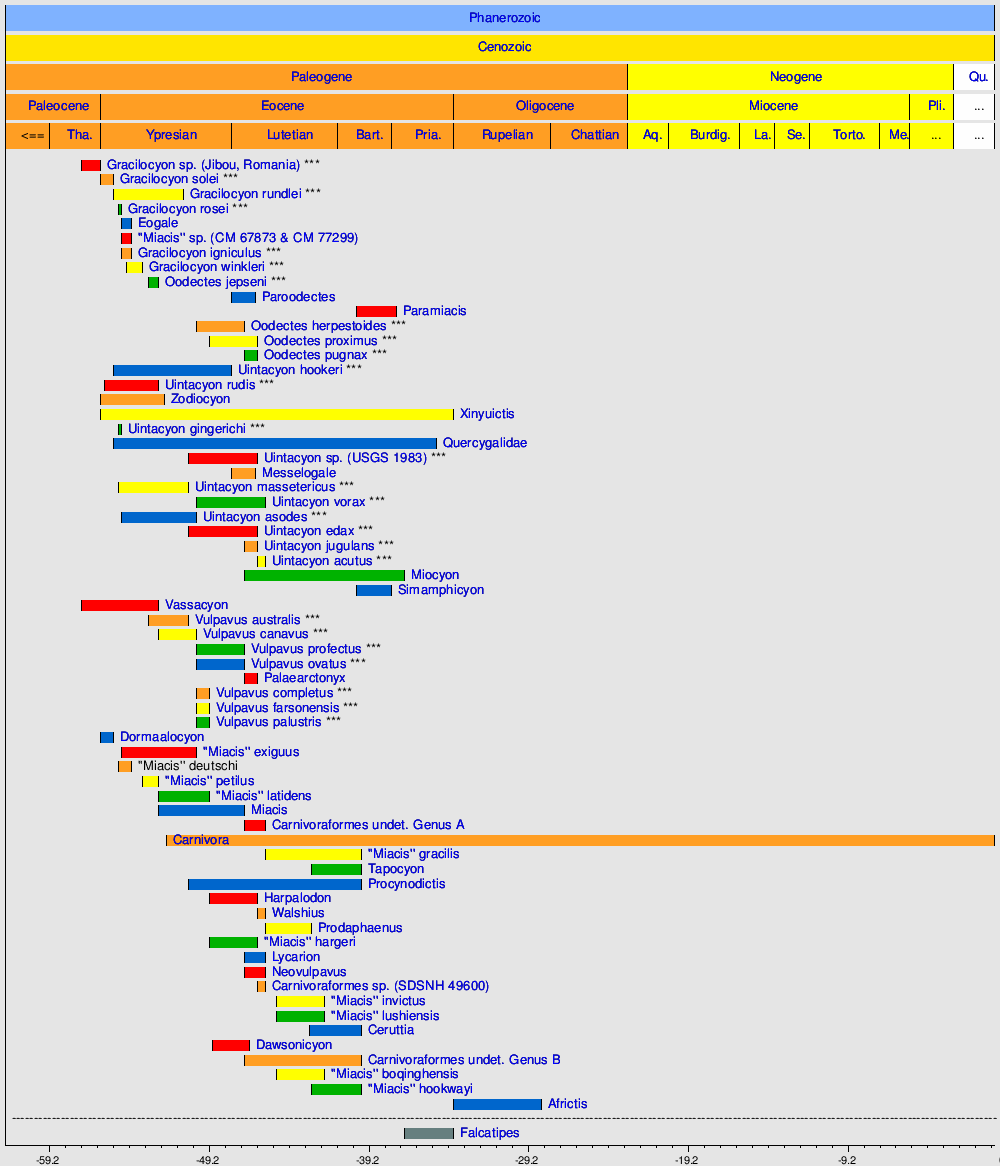Miacis deutschi
izumrla vrsta placentalni sisara
"Miacis" deutschi је изумрла врста плацентални сисара из кладуса Carnivoraformes, која је у периоду раног еоцена настањивала подручје Сјеверне Америке.[1][2]
| "Miacis" deutschi Временски распон: рани еоцен
| |
|---|---|
| Научна класификација | |
| Царство: | |
| Тип: | |
| Класа: | |
| (нерангирано): | |
| (нерангирано): | |
| (нерангирано): | |
| Род: | |
| Врста: | †"Miacis" deutschi Gingerich, 1983
|
Етимологија назива
уреди| Врста: | Поријекло назива од: | Значење назива: |
|---|---|---|
| "M." deutschi |
|
дојчов Мијакис |
Опис
уредиВрста "Miacis" deutschi је тежила око 388 g.[3]
Систематика
уредиИсторија класификације
уредиВрста "Miacis" deutschi је раније била уврштена унутар изумрлог рода Miacis, но у каснијим истраживањима је ова врста препозната као засебан представник кладуса Carnivoraformes.
Класификација
уреди| Врста: | Распрострањеност фосила и локација: |
Временски распон: |
|---|---|---|
| †"Miacis" deutschi (Gingerich, 1983)[4] | САД (Вајоминг) | 54,9 до 54,1 мил. год. |
Филогенија
уредиДоље приказан кладограм представља филогенетске везе врсте "Miacis" deutschi.[5][6][7][8]
| Carnivoramorpha |
|
†Gracilocyon/Oodectes група †Vulpavus група | |||||||||||||||||||||||||||||||||||||||||||||||||||||||||||||||||||||||||||||||||||||||||||||||||||||||||||||||||||||||||||||||||||||||||||||||||||||||||||||||||||||||||||||||||||||||||||||||||||||||||||||||||||||||||||||||||||||||||||||||||||||||||||||||||||||||||||||||||||||||||||||||||||||||||||||||||
| (Carnivora [sensu lato]) | |||||||||||||||||||||||||||||||||||||||||||||||||||||||||||||||||||||||||||||||||||||||||||||||||||||||||||||||||||||||||||||||||||||||||||||||||||||||||||||||||||||||||||||||||||||||||||||||||||||||||||||||||||||||||||||||||||||||||||||||||||||||||||||||||||||||||||||||||||||||||||||||||||||||||||||||||||
Временска распрострањеност врсте "Miacis" deutschi унутар кладуса Carnivoraformes
уреди
Види још
уредиРеференце
уреди- ^ Heinrich, R. E.; Strait, S. G.; Houde, P. (2008). „Earliest Eocene Miacidae (Mammalia: Carnivora) from northwestern Wyoming”. Journal of Paleontology. 82 (1): 154—162. doi:10.1666/05-118.1.
- ^ K. D. Rose, A. E. Chew, R. H. Dunn, M. J. Kraus, H. C. Fricke and S. P. Zack (2012) "Earliest Eocene mammalian fauna from the Paleocene-Eocene Thermal Maximum at Sand Creek Divide, southern Bighorn Basin, Wyoming." University of Michigan Papers on Paleontology 36:1-122
- ^ Juhn, M. S.; Balisi, M. A.; Doughty, E. M.; Friscia, A. R.; Howenstine, A. O.; Jacquemetton, C.; Marcot, J.; Nugen, S.; Van Valkenburgh, B. (2024). „Cenozoic climate change and the evolution of North American mammalian predator ecomorphology”. Paleobiology: 1—10. doi:10.1017/pab.2024.27 .
- ^ P. D. Gingerich (1983) "Systematics of Early Eocene Miacidae (Mammalia, Carnivora) in the Clark's Fork Basin, Wyoming." Contributions from the Museum of Paleontology, University of Michigan 26(10):197-225
- ^ Flynn, John J.; Finarelli, John A.; Spaulding, Michelle (2010). „Phylogeny of the Carnivora and Carnivoramorpha, and the use of the fossil record to enhance understanding of evolutionary transformations”. Ур.: Goswami, Anjali; Friscia, Anthony. Carnivoran evolution. New views on phylogeny, form and function. Cambridge University Press. стр. 25–63. ISBN 9781139193436. doi:10.1017/CBO9781139193436.003.
- ^ Solé, Floréal; Smith, Richard; Coillot, Tiphaine; de Bast, Eric; Smith, Thierry (2014). „Dental and tarsal anatomy of Miacis latouri and a phylogenetic analysis of the earliest carnivoraforms (Mammalia, Carnivoramorpha)”. Journal of Vertebrate Paleontology. 34 (1): 1—21. ISSN 0272-4634. doi:10.1080/02724634.2013.793195.
- ^ Solé, Floréal; Smith, Thierry; De Bast, Eric; Codrea, Vlad; Gheerbrant, Emmanuel (2016). „New carnivoraforms from the latest Paleocene of Europe and their bearing on the origin and radiation of Carnivoraformes (Carnivoramorpha, Mammalia)”. Journal of Vertebrate Paleontology. 36 (2): e1082480. ISSN 0272-4634. doi:10.1080/02724634.2016.1082480.
- ^ Tomiya, S.; Zack, S. P.; Spaulding, M.; Flynn, J. J. (2021). „Carnivorous mammals from the middle Eocene Washakie Formation, Wyoming, USA, and their diversity trajectory in a post-warming world”. Journal of Paleontology. 95 (Supplement S82): 1—115. doi:10.1017/jpa.2020.74.